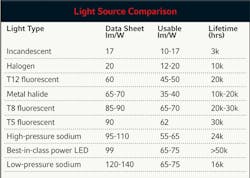Moving LEDs into the Mainstream
By Mark McClear
LEDs (light-emitting diodes) have made amazing progress in the past decade. High-power LEDs, like those found in many architectural applications, have surpassed the efficacy performance of nearly every conventional light source, and individual LED lamps are available with lumen output as high as 1,000 lumens. Small arrays of efficient, bright LEDs can now challenge HID applications of 400 watts and higher; over the last 6 to 8 years, the cost of LEDs in lumens per dollar has come down dramatically, enabling an ever-increasing range of commercial applications.
This progress is remarkable, yet significant hurdles exist before the broad-scale adoption of solid-state lighting (SSL) will be fully realized. Manufacturers are working to bridge the gap and, ultimately, to make SSL ubiquitous in outdoor and indoor general lighting applications.
LEDs differ from traditional lamp technologies in two ways. First, LEDs produce purely directional light as opposed to omni-directional light from traditional lamps. This affords many options for stylish, functional luminaires that conserve lumens and maximize energy efficiency. The second difference is in how LEDs deal with heat. Traditional lamps typically radiate significant amounts of heat in the UV and IR bands of the spectrum. LEDs, on the other hand, typically have 0 UV or IR emissions; the heat generated must be conducted away via heat sinking and other thermal strategies.
There are many other important elements of LED technology as well, such as zero restrike, infinite dimming, color changing, cold-temperature performance (LEDs are actually brighter in sub-zero-degree environments), environmental benefits, etc. LEDs also offer very long service lifetimes - under normal operating conditions, LEDs can achieve an L70 Lumen Maintenance lifetime of 50,000 hours or more, which offers significant advantages in outdoor lighting (where maintenance avoidance can deliver sizeable cost advantages). All of these benefits can be realized with a fixture that was designed from the ground up as a solid-state lighting fixture.
Continued advancements in LED performance and rapid cost reductions are expected going forward. In the next 5 years, the U.S. Department of Energy (DOE) predicts another 90-percent improvement in brightness and efficacy from LED technology; in fact, the DOE has recently increased the rate of improvement shown by its estimates. During the same period, historic norms indicate that the LED industry could improve the lumens-per-dollar equation by an additional 70 to 100 percent, making the economic case for LED adoption even more compelling.
The first LED-based outdoor lighting applications are emerging, but these installations are merely scratching the surface of the potential market. New standards on measurement, lifetime, and chromaticity are expected to be approved by the Illuminating Engineering Society of North America (IESNA) and ANSI in the next few months, and the DOE recently published new Solid-State Lighting ENERGY STAR® criteria; both of these efforts are expected to be enabling for SSL. LED technology has achieved sufficient brightness, efficiency, and affordability for many outdoor and indoor applications - performance and economics are only going to improve over time.
Mark McClear is director of business development at Durham, NC-based Cree Inc. (www.cree.com).

